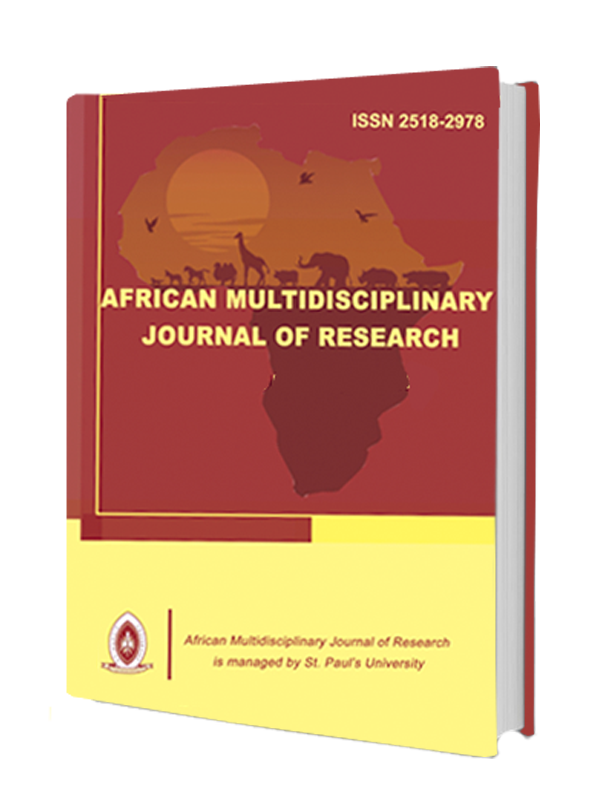Effects of Religious Dissociation on Evangelization and Discipleship of Women in Woman-Woman Marriage among the Nandi people of Kenya
##plugins.themes.academic_pro.article.main##
Abstract
The Great Commission to make all nations as the Disciples of Christ is still alive today as it was when made by Jesus 2000 years ago. The challenge to performing this duty is however, hindered by denominational policies and theologies established by missionaries, who sometimes had little understanding of the Kenyan varied cultures, and which have been continually implemented by the Kenyan leaders without critique, for they were assumed to be the only way scripture ought to be interpreted. Barrenness is one of the issues that have concerned the Nandi people since time immemorial. To take control over the issue where a woman become unable to get children of her own, she would be masculinised- becoming a man, and taking a wife. The new wife would bear children who belong to her female husband. While this arrangement is socially acceptable, the women and children born in this arrangement go through the prejudice of religious dissociation, because of the adultery tag attached to them. The study sought to find out how religious dissociation as practiced by selected denomination in Nandi County has affected the attitude of those women and children towards God. The method used was ethnography. Key informants were 16 women and 9 children, all selected from woman-to-woman marriage arrangements, and who were accessed using snowball technique. Additionally, 3 church leaders and one community elder were interviewed to give expert information about study. The study found that the underlying assumptions of woman-to-woman marriage were land ownership, inheritance, wealth security, preservation of family name, shelter for children born out of wedlock, and the social standing of barren women. The study also found that women and children have gone through sad experiences due to religious dissociation, for example their children were not dedicated to the Lord while young. As a result, many members in these arrangements, endure church membership, are not sure of their standing before God, and most prefer to stay out of church, rather than face the embarrassment. This paper recommends a proper African Christian Theology to help Christian denominations in Nandi address this problem in a way that will affirm a biblical position and enable women and children in the woman-woman marriage to exercise their faith God in a fulfilling way.
Keywords: Religious Dissociation, Biblical Interpretation, Woman, Theology, African, Culture, Nandi, Christian fellowship, Barrenness.
##plugins.themes.academic_pro.article.details##
References
- Achebe, C. (1958). Things Fall Apart. London: Heinemann.
- Asamoah-Gyadu, J. K. (2007). Broken Calabashes and Covenants of Fruitfulness‟: Cursing Barrenness in Contemporary African Christianity. Journal of Religions in Africa, 37, 437-460.
- Butler, J. (2004). Undoing Gender. London: Routledge.
- Cadigan, R. J. (1998). Woman-to-woman marriage: practices and benefits in Sub-Saharan Africa. Journal of Comparative Family Studies, 1-7.
- Ekeridge, W. N. (1993, January 1). A History of Same Sex Marriage. Faculty Scholarship Series, Paper 1504, 1419-1513. Retrieved from http://digitalcommons.law.yale.edu/fss_papers/1504
- Gehman, R. (1987). Doing African Christian Theology. Nairobi, Kenya: Evangel Publishing House.
- Herskovits, M. (1937). A note on ‟woman marriage‟ in Dahomey. Africa, 10(1), 335-341. Kimutu, S. (1998). Woman-to-Woman Marriage: Practices and Benefits in Subsaharan Africa.
- Journal of Comparative Familisy Studies, 29, 1-11.
- Nyanungo, H. (2014, January 10th ). Female Husbands without Male Wives: Women, culture and marriage in Africa. Open Society Initiative for Southern Africa (OSISA).
- Oboler, R. S. (1980). Is the female husband a man?:Woman/woman marriage among the Nandi of Kenya. Ethnology, 19(1), 69-88.
- Oduyoye, M. A. (1999). A Coming Home to Myself: Th e Childless Woman in the West African Space. In M. A. (eds.), Liberating Eschatology: Essays in Honor of Letty M. Russell (pp. 105-120). Louisville, KY: Westminister John Knox.
- Parrat, J. (1997). A Reader in African Christian Theology. London: SPCK.
- United Nations Education SCO (UNESCO). (2001). Universal Declaration on Cultural Diversity.

